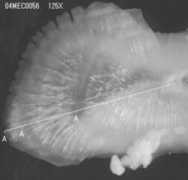Adaptation
The drum ascertains itself in its environment by using otoliths, earbones found in the inner ear, that are sensitive to gravity and linear acceleration. Otoliths are made up of a combination of a gelatinous matrix and calcium carbonate. The age of the drum can be calculated according to this structure as it grows with the drum. To read more about the uses of this unique structure by humans follow the link~ Facts. The drum also orients itself by the lateral line, a sense organ used to detect motion in the water. It is the only freshwater fish in which the lateral line runs straight down the body all the way into the tail.
The Freshwater Drum is unique in that every member of its family Sciaenidae has an elaborate swimbladder which acts as a resonating chamber, amplifying the noises produced by the adjacent muscles. This sound production is voluntary and mostly created by males. Drumming generally occurs after sunset and during spawning season when the male "drums" to attract his mate. Read Reproduction to learn more.
The drum has adapted to its environment with the development of modified pharyngeal teeth which crush the shells of mollusks, its main food source. To learn more check out Interactions


